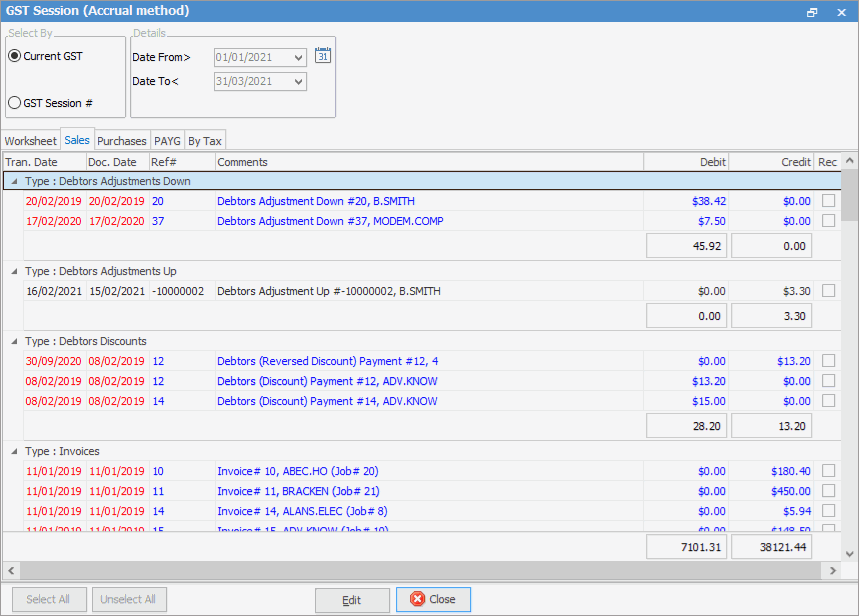
1.If you change from cash to accrual GST
Any changes are not automatically up in the saved session. You need to edit the GST Session, click Unselect All and choose All Types, then Select All, All Types (to pick up any changes, then Save and review again.

2.If you are on accrual GST, and the GST figures in the GST session do not agree with the balance sheet GST liability account balances
The figures generated in GST sessions should agree with the balance in the GST liability accounts for the same period.
Where to look if not? The problem is most likely to be caused by something out of the ordinary, as the regular transactions will be reporting correctly.
▪Were the correct opening balances brought across into Jim2?
▪Have the BAS payments (or refunds) been applied to the relevant liability accounts correctly?
▪Have any general journals (or expense POs) been posted directly against the GST accounts using tax code X?
▪Did you pay the BAS in full? (If not, refer to 4 below.)
To check for GJ sales, GJ purchases or expense PO entries directly to the GST liability accounts, run an account inquiry against each of the GST liability accounts for the relevant period, and investigate as follows:
▪Group the transactions by the Type column header to identify anything out of the ordinary, eg. a GJ purchases or GJ sales. If you find GJ purchase or GJ sale entries, you should review each entry, as you may need to reverse them and record the entry differently.
▪Remove the grouping.
▪Group the transactions by the Tax column header to identify anything out of the ordinary, eg. the use of tax code X on an expense PO or tax code C in the GST Collected on Sales account (C should only be used for capital acquisitions, which are purchases).
▪Make any corrections as necessary, then re-run the GST session.
2.If the payroll figures do not agree with the figures reporting into W1 and W2 in the GST session
The figures in W1 and W2 are generated from working with tax codes on your payroll general journals. Tax code P flags transactions to report into W1 (Gross Wages & Salaries) on the Worksheet tab in GST sessions. Tax code Q flags transactions to report into W2 (PAYG withheld from wages) on the Worksheet tab in GST sessions. Incorrect use of either tax code P or tax code Q will impact on the figures reporting into W1 or W2. Refer to Tools > Setups > Tax Codes for further information.
Review the PAYG tab in the GST session to see if there are any payments to the Australian Taxation Office appearing there – this will most likely indicate the use of tax code Q on a payment, instead of tax code X. If so, add a general journal to reverse the use of Q, and select tax code X to correct the entry, then re-run the GST session. Run an account inquiry against the Wages and Salaries expense account for the relevant period, and investigate as follows:
▪Group the transactions by the Tax column header to identify anything out of the ordinary, eg. the use of tax code X instead of P.
▪Make any corrections as necessary, then re-run the GST session.
Run an account inquiry against the PAYG liability account for the relevant period, and investigate as follows:
▪Group the transactions by the Tax column header to identify anything out of the ordinary, eg. the use of tax code X instead of Q.
▪Make any corrections as necessary, then re-run the GST session.
3.Calculating the PAYG instalment income tax amount payable
Jim2 does not calculate this figure for you – it must be calculated manually, then entered into Field 5A on the Worksheet tab before the GST session is reconciled.
▪On the ribbon, go to Management > Business Analysis > Profit and Loss, select the date range for the relevant period, then click Run.
▪Right click and select Export Data from the drop-down list, select the location to save the file, and save as a spreadsheet (XLSX) file.
▪Edit the a spreadsheet file to calculate the amount payable by taking the gross income total and multiplying by the rate notified by the ATO.
4.Updating your liability accounts when you have an instalment payment plan with the Australian Taxation Office (ATO)
You should add a 2-XXXX Liability account, such as GST Clearing or ATO Liability account to track your total debt to the ATO when not paying your BAS in full, or if you have an instalment arrangement.
▪When you complete a GST session, add a general journal to record the amount payable against the 2-XXXX ATO Liability account, and allocate the amounts exactly as lodged on your BAS to the relevant general ledger accounts to keep the running balances correct in the same way you would record a payment to the ATO.
▪When you make a payment to the ATO, record the amount of the payment against the 2-XXXX ATO Liability account to reduce the balance owing.
|
For further assistance with completing a GST Session, contact the support team at Happen Business on 02 9570 4696, or support@happen.biz |
Further information:
